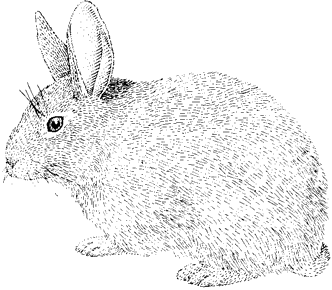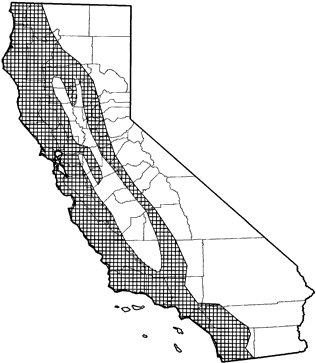
Brush Rabbit
Distribution, Abundance, and Seasonality
Abundant, yearlong resident of dense, brushy areas, and of early successional stages of oak and conifer habitats. Inhabits the length of the state west of the Sierra Nevada, excluding the dry Central Valley and southern arid regions.

Range Map
Specific Habitat Requirements
Feeding: Brush rabbits are herbivorous. They graze on a wide variety of grasses and forbs (e.g., clovers, foxtails, bromes, thistles) in grasslands, meadows, and riparian areas, always within, or very close to, dense brushy cover (Orr 1940). Brush rabbits also browse, especially in fall and winter, on tender leaves, twigs, buds, and bark of blackberry, wild rose, and other species (Chapman 1974).
Cover: Dense brush cover of thickets, vines, brambles, or dense riparian species form the center of the brush rabbit life. Blackberry and willow patches are favored coverts.
Reproduction: Brush rabbits nest in cavities, dug or natural, approximately 7.5 to 15 cm (3 to 6 in) deep, in the ground, usually beneath brushy cover. The nest is lined with dry vegetation, and/or fur, and often it is plugged with dry vegetation (Davis 1936, Orr 1940,1942).
Water: No data found for water requirements of wild brush rabbits, but they drink freely in captivity.
Pattern: Brush rabbits occur in relatively small areas of shrub/herbaceous edge, and in early successional stages of many habitats.
Species Life History
Activity Patterns: Usually most active during crepuscular periods; less active at night, and occasionally active in daytime, often on cloudy, or overcast days (Maser et al. 1981). Active throughout the year (Orr 1940, Pearson 1959).
Seasonal Movements / Migration: Sedentary.
Home Range: In California, male home ranges averaged 1.5 ha (3.8 ac), and home ranges for females averaged 0.5 ha (1.3 ac) (Connell 1954, Shields 1960). In Oregon, home ranges varied between 0.2 and 0.8 ha (0.5 to 2.0 ac) (Chapman 1971). Home ranges often conform to the size and shape of cover patches. Homing ability extends up to 350 m (1150 ft) (Chapman 1971).
Territory: Males apparently are not territorial; home ranges overlap. Females sometimes protect areas: Connell (1954) and Shields (1960) reported female territories 12-173 m (38-569 ft) in diameter.
Reproduction: Breeding occurs from January through August, with most activity from March through June. Females produce 2-4 litters per yr, of 1-6 young (average 3-4) (Chapman and Harman 1972). Gestation period is 27-30 days, and lactation generally is completed by August. Young brush rabbits remain in the nest approximately 2 wk (Davis 1936, Orr 1940 Chapman and Harman 1972).
Niche: Predators of brush rabbits include bobcats coyotes, gray foxes, domestic dogs and cats, long-tailee weasels, minks, spotted skunks, striped skunks, red tailed hawks, Cooper's hawks, barn owls, rattlesnakes and gopher snakes (Bryant 1918, Dixon 1925, Foster 1927, Sumner 1929, Orr 1940). Brush rabbits may compete with other grazing and browsing species for food. Occasionally they damage Douglas-fir seedlings, other seedlings, and gardens.
Comments: S. b. riparius is a California Species of Special Concern (Williams 1986).
Sources & References
California Department of Fish and Game, 1999.
California's Wildlife, Sacramento, CA.
Written by: C. Polite, reviewed by: M. White, edited by: M. White
Bryant, H. C. 1918. Evidence on the food of hawks and owls in California. Condor 20:126-127. Chapman, J. A. 1971. Orientation and homing of the brush rabbit (Sylvilagus bachmani). J. Mammal. 686-699. Chapman, J. A. 1974. Sylvilagus bachmani. Mammal. Species No. 34. 4pp. Chapman, J. A., and A. L. Harman. 1972. The breeding biology of a brush rabbit population. J. Wildl. Manage. 36:816-823. Connell, J. H. 1954. Home range and mobility of brush rabbits in California chaparral. J. Mammal. 35:392-405. Davis, W. B. 1936. Young of the brush rabbit, Sylvilagus bachmani. Murrelet 17:36-40. Dixon, J. 1925. Food predilections of predatory and fur-bearing mamnmals. J. Mammal. 6:34-46. Foster, G. L. 1927. A note on dietary habits of the barn owl. Condor 29:246. Fox. C. 1926. Some new Siphonaptera from California. Pan Pac. Entom. 2:182-187. Maser, C., B. R. Mate, J. F. Franklin, and C. T. Dyrness. 1981. Natural history of Oregon coast mammals. Pac. Northwest For. And Range Exp. Sta., USDA, For. Serv., Gen. Tech. Rep., PNW-133. 496pp. Mossman, A. S. 1955. Reproduction of the brush rabbit in California. J. Wildl. Manage. 19:177-184. Orr, R. T. 1940. The rabbits of California. Calif. Acad. Sci. Occas. Pap. No. 19. 227pp. Orr, R. T. 1942. Observations on the growth of young brush rabbits. J. Mammal. 23:298- 302. Pearson, O. P. 1959. A traffic survey of Microtus-Reithrodontomys runways. J. Mammal. 40:169-180. Shields, P. W. 1960. Movement patterns of brush rabbits in northwestern California. J. Wildl. Manage. 24:381-386. Sumner, E. L., Jr. 1929. Comparative studies in the growth of young raptors. Condor 31:85-111. Williams, D. F. 1986. Mammalian species of special concern in California. Calif. Dept. Fish and Game, Sacramento. Admin. Rep. 86-1. 112pp.
California Animal Facts | California's Wildlife